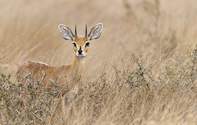
Initial findings indicate that oribi numbers in South Africa are still decreasing from previous years. According to land owners who participated in the Endangered Wildlife Trust's Oribi Working Group (EWT-OWG) survey, the primary reason for the continued decrease in oribi numbers is illegal hunting (poaching).
According to Andre Rossouw, field worker for the EWT-OWG, the response to the 2007 national oribi (Ourebia ourebi) census was very positive. 'It was the first year that a conscious effort was made to count oribi throughout their range, which includes the Eastern Cape, KwaZulu-Natal, Free State, Mpumalanga, Gauteng and North West provinces of South Africa.'
He says that although there are still some census forms trickling in, the EWT-OWG has received 185 returns to date with a combined total of 993 oribi counted in 2007. The majority of the returns are from KwaZulu-Natal and Mpumalanga. These are the two provinces with the largest oribi populations.
An alarming statistic is that half of the population occurs in groups of five or less animals. Often these small populations are isolated from one another in small islands of grassland. About a quarter of the returns indicate that the oribi populations on those properties are stable, while another quarter indicates that oribi numbers are decreasing. The remaining half do not indicate whether there has been any change.
The EWT-OWG considers September to be the best month in which to count oribi, as this is after the spring burns when the grass is flushing and short. The oribi congregate on these areas of short green grass to feed and are therefore easier to see and count. However, this is a recommendation rather than a specification.
Numerous land-owners and conservancies do their annual game counts earlier, around July, while other land-owners burn a little later and so choose to do their count later. Although the EWT-OWG coordinates a national oribi count every two years, the group is interested in receiving the results from land-owners that conduct annual counts of their oribi irrespective of when in the year the counts take place.
The national bi-annual oribi count serves a number of functions:
- It allows the EWT-OWG to determine trends in the population that can assist in future conservation management decisions regarding this endangered species. This is achieved over time when returns for the same areas or properties are received and the numbers can be compared.
- It allows the EWT-OWG to determine the current primary threats to oribi and implement appropriate conservation measures.
- It involves land-owners in the conservation of oribi and in the conservation activities of the EWT-OWG.
The oribi is specialised and inhabits only African temperate grasslands. In South Africa, its numbers have declined sharply in recent years, primarily due to habitat destruction, illegal hunting (poaching) and inappropriate management.
It currently exists in only a few formally protected areas, with the bulk of the population occurring on privately owned land. South Africa's Red Data Book of Mammals (2004) classifies the oribi as endangered.
'A huge thank-you to all who took the time and effort to assist in the 2007 Oribi census. Your contribution is vital to conserving Oribi and grasslands.'
'This project is made possible by the support of the Lomas Wildlife Protection Trust, NCT Forestry Co-operative Limited, The Wildlands Conservation Trust, Aquellé Karkloof Classic MTB Challenge, World Association of Zoos and Aquaria, Henri Naudé, Indawo Game Lodge, Ezemvelo KZN Wildlife and Mpumalanga Parks Board,' says Andre.
Fast Facts
- It is a grassland antelope, almost exclusively adapted to this habitat.
- Oribi populations throughout South Africa are being negatively effected by illegal dog hunting.
- Three quarters of the Oribi population in South Africa is located on privately-owned land. (EWT)
Learn more about the Oribi antelope

